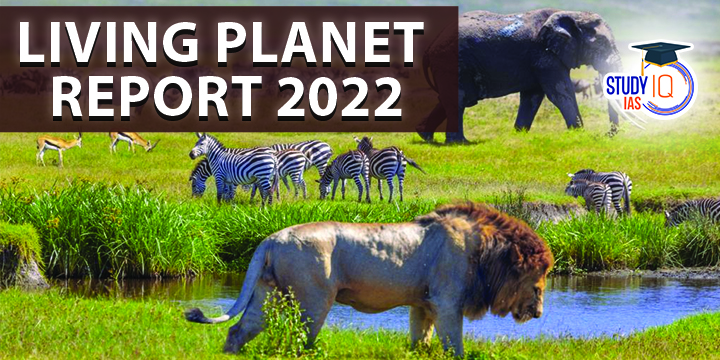Table of Contents
About The Living Planet Report 2022
- The Living Planet Report 2022 is published every 2 years by the World Wide Fund for Nature (WWF) since 1998.
- Living Planet Report is a comprehensive study of the trends in global biodiversity and the health of the planet. It tracks changes in the relative abundance of wild species populations across the globe.
Major Findings of The Living Planet Report 2022
- Living Planet Report on Biodiversity loss
- There has been a 69 per cent decline in the wildlife populations of mammals, birds, amphibians, reptiles, and fish, across the globe in the last 50 years.
- The freshwater species have declined the most, with an 83% decline between 1970 and 2018.
- The highest decline (94 per cent) was in the Latin America and the Caribbean region.

- Key threats to biodiversity
- WWF identified six key threats to biodiversity — agriculture, hunting, logging, pollution, invasive species and climate change.
- Land-use change: It is still the biggest current threat to nature, destroying or fragmenting the natural habitats of many plant and animal species on land, in freshwater and in the sea.
- Climate change: Rising temperatures are already driving mass mortality events, as well as the first extinction of an entire species. Every degree of warming is expected to increase these losses and the impact they have on people.
- Habitat loss and barriers to migration routes were responsible for about half of the threats to monitored migratory fish species.
- Agriculture is the most prevalent threat to amphibians.
- Hunting and trapping are the most prevalent threats to birds and mammals.
- Coral reefs:
- About 50% of warm-water corals have already been lost due to variety of causes.
- A warming of 1.5°C will result in a loss of 70-90% of warm-water corals, and a 2°C will result in a loss of more than 99%.
- Mangroves:
- Despite their importance, mangroves continue to be deforested by aquaculture, agriculture and coastal development at a rate of13% annually.
- The report stated that many mangroves are degraded by over-exploitation and pollution, alongside natural stressors such as storms and coastal erosion.
- Mangrove loss represents not only the loss of habitat for biodiversity, but also the loss of ecosystem services and livelihood for coastal communities.
- For instance, 137 km of the Sundarbans mangrove forest have been eroded since 1985, reducing land and ecosystem services for many of the 10 million people who live there.
- Sharks:
- The global abundance of 18 of 31 oceanic sharks has declined by 71% over the last 50 years.
- The report said that by 2020, three-quarters of sharks and rays were threatened with extinction.
- Other Important Findings:
- Only 37% of rivers that are over 1,000 km long remain free-flowing, or in their natural state, including rivers in India that are largely no longer free-flowing.
- We are facing the double emergencies of human-induced climate change and biodiversity loss: threatening the well-being of current and future generations.
India Specific Findings Of Living Planet Report 2022 India
- Himalayan region and Western Ghats are among the most vulnerable regions of the country to biodiversity loss, which will be aggravated by rising temperatures in the future.
- India has seen a decline in population of the likes of honeybees and 17 species of freshwater turtles between 1970 and 2018.
- Climate change in India will impact key areas, such as water resources, agriculture, natural ecosystems, health and the food chain.
Living Planet Report: Way forward
- By moving to sustainable, healthy, and culturally appropriate diets we can reduce agricultural land use by 41% and wildlife loss by up to 46%.
- Biodiversity loss and climate crisis should be dealt with as one instead of two different issues as they are intertwined.
- There is an urgent need for a nature-positive future which includes transformative, game-changing shifts in how we produce, how we consume, how we govern and what we finance.
- There is a need for an all-inclusive collective approach that can put us on a more sustainable path and ensures that the costs and benefits from our actions are socially just and equitably shared.


 Bharat Bandh 9 July 2025: Over 25 Crore ...
Bharat Bandh 9 July 2025: Over 25 Crore ...
 UPPSC Mains Question Paper 2025: Downloa...
UPPSC Mains Question Paper 2025: Downloa...
 Sukhoi Su-57: Will India Choose Russia�...
Sukhoi Su-57: Will India Choose Russia�...





















